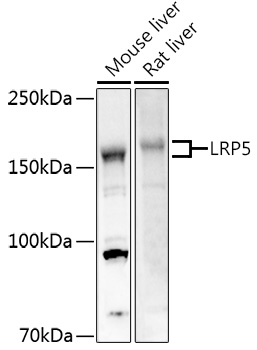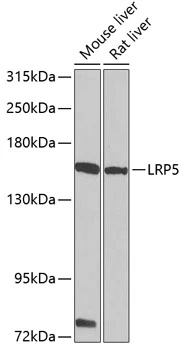![ELISA analysis of antigen using GTX60567 LRP5 antibody [2B11]. Black : Control antigen 100ng Purple : Antigen 10ng Blue : Antigen 50ng Red : Antigen 100ng ELISA analysis of antigen using GTX60567 LRP5 antibody [2B11]. Black : Control antigen 100ng Purple : Antigen 10ng Blue : Antigen 50ng Red : Antigen 100ng](https://www.genetex.com/upload/website/prouct_img/normal/GTX60567/GTX60567_20170912_ELISA_w_23061123_473.webp)
ELISA analysis of antigen using GTX60567 LRP5 antibody [2B11]. Black : Control antigen 100ng Purple : Antigen 10ng Blue : Antigen 50ng Red : Antigen 100ng
LRP5 antibody [2B11]
GTX60567
ApplicationsFlow Cytometry, Western Blot, ELISA
Product group Antibodies
TargetLRP5
Overview
- SupplierGeneTex
- Product NameLRP5 antibody [2B11]
- Delivery Days Customer9
- Application Supplier NoteWB: 1/500 - 1/2000. FACS: 1/200 - 1/400. ELISA: 1/10000. *Optimal dilutions/concentrations should be determined by the researcher.Not tested in other applications.
- ApplicationsFlow Cytometry, Western Blot, ELISA
- CertificationResearch Use Only
- ClonalityMonoclonal
- Clone ID2B11
- Concentration1 mg/ml
- ConjugateUnconjugated
- Gene ID4041
- Target nameLRP5
- Target descriptionLDL receptor related protein 5
- Target synonymsBMND1, EVR1, EVR4, HBM, LR3, LRP-5, LRP-7, LRP7, OPPG, OPS, OPTA1, PCLD4, VBCH2, low-density lipoprotein receptor-related protein 5, low density lipoprotein receptor-related protein 5, low density lipoprotein receptor-related protein 7
- HostMouse
- IsotypeIgG1
- Protein IDO75197
- Protein NameLow-density lipoprotein receptor-related protein 5
- Scientific DescriptionThis gene encodes a transmembrane low-density lipoprotein receptor that binds and internalizes ligands in the process of receptor-mediated endocytosis. This protein also acts as a co-receptor with Frizzled protein family members for transducing signals by Wnt proteins and was originally cloned on the basis of its association with type 1 diabetes mellitus in humans. This protein plays a key role in skeletal homeostasis and many bone density related diseases are caused by mutations in this gene. Mutations in this gene also cause familial exudative vitreoretinopathy. Alternative splicing results in multiple transcript variants. [provided by RefSeq, May 2014]
- Storage Instruction-20°C or -80°C,2°C to 8°C
- UNSPSC12352203

![FACS analysis of HeLa cells using GTX60567 LRP5 antibody [2B11]. Green : LRP5 Red : negative control FACS analysis of HeLa cells using GTX60567 LRP5 antibody [2B11]. Green : LRP5 Red : negative control](https://www.genetex.com/upload/website/prouct_img/normal/GTX60567/GTX60567_20170912_FACS_w_23061123_998.webp)
![WB analysis of human LRP5 (AA: 1422-1615) recombinant protein using GTX60567 LRP5 antibody [2B11]. WB analysis of human LRP5 (AA: 1422-1615) recombinant protein using GTX60567 LRP5 antibody [2B11].](https://www.genetex.com/upload/website/prouct_img/normal/GTX60567/GTX60567_20170912_WB_w_23061123_482.webp)






